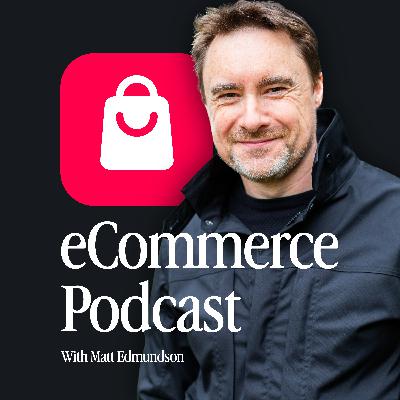How to Build a Customer Growth System With The FUEL Framework
Description
Customer acquisition costs have surged 222% since 2013, with Google and Facebook CPCs climbing relentlessly. But what if the solution isn't just doubling down on retention or throwing more money at ads?
Matt Edmundson introduces the FUEL Framework—a systematic approach to customer growth that doesn't rely on a single channel, doesn't assume yesterday's tactics will work tomorrow, and doesn't leave you vulnerable when platforms change their algorithms. Through Foundation, Unlock, Elevate, and Leapfrog strategies, this framework addresses all three levers of business growth: acquiring customers, increasing purchase frequency, and raising average order value.
Key Point Timestamps:
00:00 - Introduction: The Challenge of Rising CAC
01:00 - The iOS 14 Impact on Facebook Ads
02:00 - The CAC Crisis in eCommerce
03:00 - The Bathtub Principle
04:34 - Introducing the FUEL Framework
09:00 - Foundation: Email Beyond Templates
13:00 - Foundation: Building Referral Engines
15:00 - Foundation: Customer Experience Post-Purchase
19:00 - Unlock: Strategic Partnerships
22:00 - Unlock: Content Amplification
26:00 - Unlock: Community Seeding
28:00 - Elevate: Advanced Segmentation
32:00 - Elevate: AI-Powered Personalisation
38:00 - Leapfrog: Experimenting Without Fear
Foundation: Building Your Unshakeable Base (09:00 )
Matt challenges the common assumption that having Shopify and Google Analytics means your foundations are sorted. Real foundations aren't about having tools—they're about having systems that work even when paid ads don't.
Email marketing generates 30-40% of revenue for most eCommerce businesses, yet many brands still rely on generic templates. Matt references Ken Rapp from BluStream's brilliant rule: don't send any coupons or review requests in the first five messages. "Just deliver value. Help customers succeed with their purchase. Build trust," Matt explains. Over 90% of customers stay engaged with these journeys months—sometimes years—later.
The referral engine sits in foundations because referred customers are 16-24% more loyal than customers acquired through other channels, have 16% higher lifetime value, and cost £17 less to acquire. But standard refer-a-friend programmes don't work because they assume everyone just wants £10 off. "Maybe a complementary product has higher perceived value than cash. Maybe inviting them to a VIP board meeting matters more," Matt suggests.
The Post-Purchase Gap (15:00 )
Standing in his favourite Liverpool coffee shop, Matt had an epiphany about customer experience. The journey was brilliant until he paid—then he stood awkwardly with others, unable to listen to music in case they called his name, no bench to sit on, no system.
"I started thinking, well actually, am I doing the same thing in my own eCommerce businesses?" Matt reflects. "We obsess over the journey to checkout. We A/B test button colours, we track every click. Then someone buys, and we forget about them. Or worse—we immediately hit them with a review request before they've even opened the box."
The gap between acquisition and loyalty is where most brands lose the game. Customer experience—particularly post-purchase—directly impacts whether customers buy again.
Unlock: Diversifying Beyond Paid Ads (19:00 )
Once foundations are solid, Matt recommends devoting 5-10% of marketing resources to unlocking other channels. Strategic partnerships work because 72% of companies report lower CAC through partnerships than direct acquisition.
Matt shares his experience with Through Doc, the clothing company he frequently purchases from. When they partnered with Elliot Brown watches, he'd never heard of the watchmaker. "I ended up buying one of the Elliot Brown watches as a result of that email. Would I have done that if I'd just seen Elliot Brown ads? Maybe, maybe not. But strategic partnerships work fundamentally—you borrow the credibility of the company referring you."
Content amplification also features heavily in the Unlock phase. Matt uses the eCommerce Podcast itself as an example: audio becomes podcasts, video becomes YouTube content, written format becomes blog posts, multiple emails feed the newsletter. "We've just built a three-person studio in Nottingham. We're investing heavily because for us, this form of content creation works."
Elevate: When Good Becomes Great (28:00 )
With foundations solid and channels unlocked, the Elevate phase focuses on maximising efficiency. Advanced segmentation recognises that not all customers are equal, and treating them the same leaves money on the table.
Matt advocates for RFM segmentation—tracking customers by Recency, Frequency, and Monetary value. "How recently did they buy? What's their average order count? What's the worth of that customer? Ranking customers in those three areas gives you really interesting insight," Matt explains, recommending Valentine Radu's episode for deeper understanding.
Personalisation goes beyond mail merge. SafariLand achieved a 37% conversion increase through data-driven product page optimisation. LeSportsac saw a 7% conversion lift and 20% AOV increase after AI personalisation. "Someone who comes onto your website and doesn't know you needs a very different journey from someone who's been 50 times before and knows exactly what they need," Matt notes.
Leapfrog: Calculated Risks (38:00 )
The final phase is where brands experiment with things that might fail—because the business isn't dependent on them working. Matt shares examples like beauty brands setting up skin analysis booths at farmers' markets, collecting hundreds of high-quality email subscribers whilst meeting customers face-to-face.
One innovative tactic Matt's been exploring: creating an AI board of directors. "Add Jeff Bezos, Steve Jobs, Warren Buffett to your board. Add your target customers, add your biggest detractor. Present something to your board and watch them debate amongst themselves." The questions are harsh but remarkably good for strategic thinking.
Another powerful technique from Dan Co: take competitors' top Instagram posts or YouTube videos, order by engagement, copy the titles, and ask AI to break down why they work. "I'm not doing this to copy. I'm doing this to understand what's working, then appropriate that to your brand voice," Matt clarifies.
Today's Guest
Today's guest: Matt Edmundson
Company: Aurion
Website: aurioncompany.com
LinkedIn: Connect with Matt





